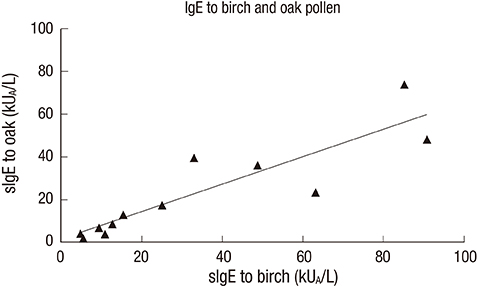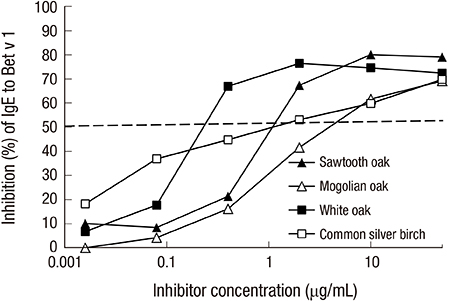Cross-Reactivity between Oak and Birch Pollens in Korean Tree Pollinosis
- Affiliations
-
- 1Department of Internal Medicine, Institute of Allergy, Yonsei University College of Medicine, Seoul, Korea. parkjw@yuhs.ac
- 2Department of Biology Education, Faculty of Education, Seowon University, Cheongju, Korea.
- KMID: 2373746
- DOI: http://doi.org/10.3346/jkms.2016.31.8.1202
Abstract
- Oak and birch trees belong to Fagales order. Specific IgE to pollen allergens of both trees are frequently found in Korea pollinosis patients. Oak trees which comprise 40% of forest area are common in Korea. However, birch trees are sparse. We compared the allergenicity of pollen extracts of white oak, sawtooth and Mongolian oaks which are prevalent species in Korea, with the pollen extract of birch. The cross-reactivity of four pollen extracts was examined with pooled sera of 12 patients by ELISA, immunoblotting and CAP inhibitions. A protein of 17 kDa, putatively homologous to a major birch allergen Bet v 1, displayed strong IgE reactivity from white oak and sawtooth oak pollen extract but not from Mongolian oak pollen. Notably, a 23-kDa protein from sawtooth and white oaks showed strong IgE reactivity and inhibited by Bet v 1. IgE binding to white oak was inhibited a maximum of 94.6% by white oak, 93.4% by sawtooth oak, 83.2% by Mongolian oak, and 68.8% by birch. Furthermore, sawtooth oak, white oak, and Mongolian oak extracts were able to inhibit up to 78.5%, 76.6% and 67.3% of IgE binding to birch extract, while birch extract itself inhibited up to 94.3%. Specific IgE to Bet v 1 was inhibited a maximum of 79.1% by sawtooth oak, 77.4% by white oak, and 72.7% by Mongolian oak, while 81.5% inhibition was shown by birch. Bet v 1 was able to partially inhibit its homologous molecules from sawtooth oak and white oak in immunoblotting. Birch pollen extract was found to be cross-reactive primarily with Bet v 1-homologous allergen from oak pollens in Korea pollinosis patients. Considering the sparseness of birch tree in Korea, oak, especially sawtooth oak may be the main cause of tree pollinosis in Korea, rather than birch.
Keyword
MeSH Terms
-
Adolescent
Adult
Allergens/*immunology
Asian Continental Ancestry Group
Betula/growth & development/*immunology
Child
Cross Reactions
Electrophoresis, Polyacrylamide Gel
Enzyme-Linked Immunosorbent Assay
Female
Humans
Hypersensitivity/*diagnosis
Immunoblotting
Immunoglobulin E/blood
Male
Middle Aged
Pollen/*immunology
Quercus/growth & development/*immunology
Republic of Korea
Allergens
Immunoglobulin E
Figure
Cited by 5 articles
-
Comparison between Newly Developed and Commercial Inhalant Skin Prick Test Reagents Using In Vivo and In Vitro Methods
Sang Chul Lee, Da Woon Sim, Jongsun Lee, Kyoung Yong Jeong, Kyung Hee Park, Jae-Hyun Lee, Jung Dong Kim, Jung-Won Park
J Korean Med Sci. 2018;33(13):. doi: 10.3346/jkms.2018.33.e101.Comparison of the ImmunoCAP Assay and AdvanSure™ AlloScreen Advanced Multiplex Specific IgE Detection Assay
Kyung Hee Park, Jongsun Lee, Sang Chul Lee, Young Woong Son, Da Woon Sim, Jae-Hyun Lee, Jung-Won Park
Yonsei Med J. 2017;58(4):786-792. doi: 10.3349/ymj.2017.58.4.786.Validation of PROTIA™ Allergy-Q 64 Atopy® as a Specific IgE Measurement Assay for 10 Major Allergen Components
Sung Ryeol Kim, Kyung Hee Park, Jae-Hyun Lee, Bum Joon Kim, Jae Hwan Hwang, Kook Jin Lim, Jung-Won Park
Allergy Asthma Immunol Res. 2019;11(3):422-432. doi: 10.4168/aair.2019.11.3.422.Clinical Features and Culprit Food Allergens of Korean Adult Food Allergy Patients: A Cross-Sectional Single-Institute Study
Sang Chul Lee, Sung-Ryeol Kim, Kyung Hee Park, Jae-Hyun Lee, Jung-Won Park
Allergy Asthma Immunol Res. 2019;11(5):723-735. doi: 10.4168/aair.2019.11.5.723.Subcutaneous Immunotherapy in Patients with Fagales Pollen-Induced Oral Allergy Syndrome
Nasil Kong, Sunyoung Kim, Sang Chul Lee, Kyung Hee Park, Jae-Hyun Lee, Jung-Won Park
Yonsei Med J. 2019;60(4):389-394. doi: 10.3349/ymj.2019.60.4.389.
Reference
-
1. Kim YL, Lee SK, Oh SH, Moon BS, Park HS, Hong CS. A study of allergy skin tests with Korean pollen extracts. Yonsei Med J. 1987; 28:112–118.2. Kim TB, Kim KM, Kim SH, Kang HR, Chang YS, Kim CW, Bahn JW, Kim YK, Kang HT, Cho SH, et al. Sensitization rates for inhalant allergens in Korea: a multicenter study. J Asthma Allergy Clin Immunol. 2003; 23:483–493.3. Lee JW, Choi GS, Kim JE, Jin HJ, Kim JH, Ye YM, Nahm DH, Park HS. Changes in sensitization rate to pollen allergens in allergic patients in the southern part of Gyeonggi province over the last 10 years. Korean J Asthma Allergy Clin Immunol. 2011; 31:33–40.4. Park HJ, Lee JH, Park KH, Ann HW, Jin MN, Choi SY, Lee YW, Hong CS, Park JW. A nationwide survey of inhalant allergens sensitization and levels of indoor major allergens in Korea. Allergy Asthma Immunol Res. 2014; 6:222–227.5. Mari A, Wallner M, Ferreira F. Fagales pollen sensitization in a birch-free area: a respiratory cohort survey using Fagales pollen extracts and birch recombinant allergens (rBet v 1, rBet v 2, rBet v 4). Clin Exp Allergy. 2003; 33:1419–1428.6. Wallner M, Erler A, Hauser M, Klinglmayr E, Gadermaier G, Vogel L, Mari A, Bohle B, Briza P, Ferreira F. Immunologic characterization of isoforms of Car b 1 and Que a 1, the major hornbeam and oak pollen allergens. Allergy. 2009; 64:452–460.7. Ebner C, Birkner T, Valenta R, Rumpold H, Breitenbach M, Scheiner O, Kraft D. Common epitopes of birch pollen and apples--studies by western and northern blot. J Allergy Clin Immunol. 1991; 88:588–594.8. Kim GS, Song HK, Lee CH, Cho HJ, Lee CS. Ecological comparison of Mongolian oak (Quercus mongolica Fisch. Ex Ledeb.) community between Mt. Nam and Mt. Jeombong as a long term ecological research (LTER) site. Korean J Environ Ecol. 2011; 34:75–85.9. Hauser M, Asam C, Himly M, Palazzo P, Voltolini S, Montanari C, Briza P, Bernardi ML, Mari A, Ferreira F, et al. Bet v 1-like pollen allergens of multiple Fagales species can sensitize atopic individuals. Clin Exp Allergy. 2011; 41:1804–1814.10. Radauer C, Lackner P, Breiteneder H. The Bet v 1 fold: an ancient, versatile scaffold for binding of large, hydrophobic ligands. BMC Evol Biol. 2008; 8:286.11. Breitenbach M, Ferreira F, Jilek A, Swoboda I, Ebner C, Hoffmann-Sommergruber K, Briza P, Scheiner O, Kraft D. Biological and immunological importance of Bet v 1 isoforms. Adv Exp Med Biol. 1996; 409:117–126.12. Byun JG, Lee WK, Kim M, Kwak DA, Kwak H, Park T, Byun WH, Son Y, Choi JK, Lee YJ, et al. Radial growth response of Pinus densiflora and Quercus spp. To topographic and climatic factors in South Korea. J Plant Ecol. 2013; 6:380–392.13. Jeong HM, Kim HR, You YH. Growth difference among saplings of Quercus acutissima, Q. variabilis and Q. mongolica under the environmental gradients treatment. Korean J Environ Biol. 2009; 27:82–87.14. Jeong KY, Hong CS, Lee JS, Park JW. Optimization of allergen standardization. Yonsei Med J. 2011; 52:393–400.15. Douladiris N, Savvatianos S, Roumpedaki I, Skevaki C, Mitsias D, Papadopoulos NG. A molecular diagnostic algorithm to guide pollen immunotherapy in southern Europe: towards component-resolved management of allergic diseases. Int Arch Allergy Immunol. 2013; 162:163–172.16. Altmann F. The role of protein glycosylation in allergy. Int Arch Allergy Immunol. 2007; 142:99–115.17. Movérare R, Everberg H, Carlsson R, Holtz A, Thunberg R, Olsson P, Brostedt P, Hogbom E. Purification and characterization of the major oak pollen allergen Que a 1 for component-resolved diagnostics using ImmuoCAP®. Int Arch Allergy Immunol. 2008; 146:203–211.18. Ferreira F, Wolf M, Wallner M. Molecular approach to allergy diagnosis and therapy. Yonsei Med J. 2014; 55:839–852.
- Full Text Links
- Actions
-
Cited
- CITED
-
- Close
- Share
- Similar articles
-
- Identification of immunoglobulin E binding components of two major tree pollens, birch and alder
- Cross - reactivity between pollens in patients sensitlzed to multiple pollens
- Pollen allergy plants in Korea
- Pollen Allergy in Children (ll): The Significance of Tree Pollen As a Causative Allergen in Children with Allergic Diseases
- Tree Pollen Sensitization and Cross-Reaction of Children with Allergic Rhinitis or Asthma





